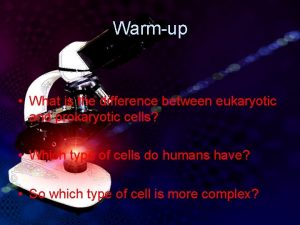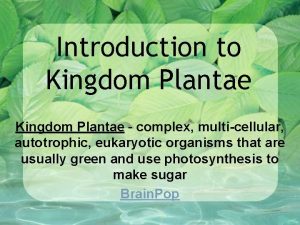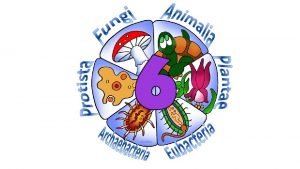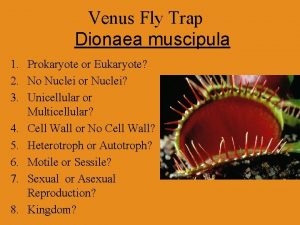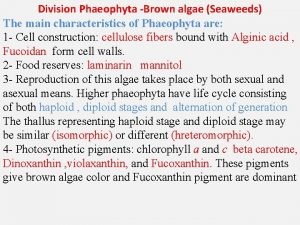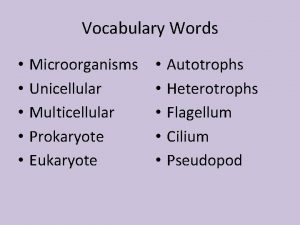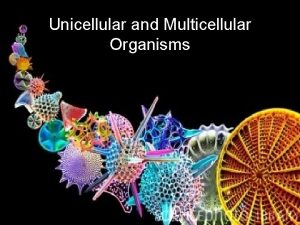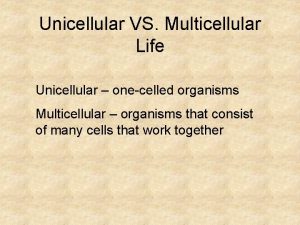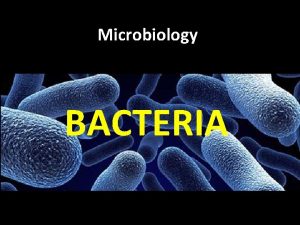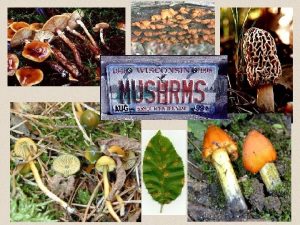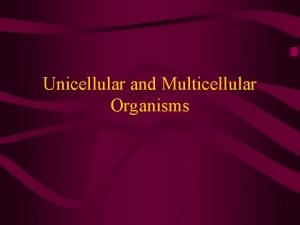Classifying Animals PROKARYOTE vs EUKARYOTE UNICELLULAR vs MULTICELLULAR














- Slides: 14

Classifying Animals - PROKARYOTE vs EUKARYOTE - UNICELLULAR vs MULTICELLULAR - Dichotomous Keys

What is biodiversity? • 3 levels of biodiversity are. . . • Genetic, Species, Ecosystem 2

Level 1: Genetic Diversity The genetic differences among species are attributed to species having different alleles of the same gene. 3

Genetic Diversity • Why is it important? • Gene pool: the sum of all the versions of all the genes (alleles) in a population • How do you define a population? Ø Same species, area and time. • Would there be a greater genetic diversity within a species or a pop’n?

Within a species. White-cheeked Rosella, showing genetic variation that is geographically based Within a population. Spring Beauty, where different genetic strains are found in the same forest. 5

Homo sapiens, where genetic diversity has a geographic pattern, but which shows much diversity within local populations too. 6

Distribution of O blood type in South America The O allele is almost fixed whereas A is rare and B is absent)

Level 2: Species Diversity Beetles: Over 350, 000 species on Earth 8

Species Diversity • The variety and abundance of species in a given area. – E. g. populations, subspecies, “races” • Species diversity helps conservationists decide where to concentrate efforst 9

Species Diversity is all around us… • “Researcher Finds New Bee Species in Downtown Toronto” (2010) • A York University Ph. D. student, who discovered a new species of bee on his way to the lab one morning, has completed a study that examines 84 species of sweat bees in Canada… 10

Level 3: Ecosystem Diversity Ecosystems are hard to characterize since (a) boundaries are often “soft”, and (b) no two landscapes are really the same. 11

Ecosystem Diversity • The variety of ecosystems in the biosphere. • Ecosystems provide “ecosystem services” – Each a different organ in the body of earth – Pg. 37 #9 • They are resilient • Why is it bad for humans to alter ecosystems to enhance its “services”? 12

Ecosystem Diversity • Which of the following are ecosystems? a) b) c) d) e) Flower basket Surface of your skin Schoolyard Lake Ontario The tundra • What do your answers tell you about ecosystem diversity? 13

Homework • Create a dichotomous key for Kingdoms – Use Table 1. 5 on page 29 as a guide
 Prokaryotic vs eukaryotic cells worksheet
Prokaryotic vs eukaryotic cells worksheet Chloroplast prokaryote or eukaryote
Chloroplast prokaryote or eukaryote Eukaryote prokaryote difference
Eukaryote prokaryote difference Is protist a prokaryote or eukaryote
Is protist a prokaryote or eukaryote Plant - multicellular eukaryote of the kingdom plantae
Plant - multicellular eukaryote of the kingdom plantae Is eubacteria multicellular or unicellular
Is eubacteria multicellular or unicellular Is a venus fly trap prokaryotic or eukaryotic
Is a venus fly trap prokaryotic or eukaryotic Nerve cell specialization
Nerve cell specialization Chilicerata
Chilicerata Salient features of phaeophyta pdf
Salient features of phaeophyta pdf Aspergillus type of fungus
Aspergillus type of fungus How are unicellular and multicellular organisms alike
How are unicellular and multicellular organisms alike Single celled and multicellular organisms
Single celled and multicellular organisms Phycophyta algae
Phycophyta algae Fungi multicellular or unicellular
Fungi multicellular or unicellular


